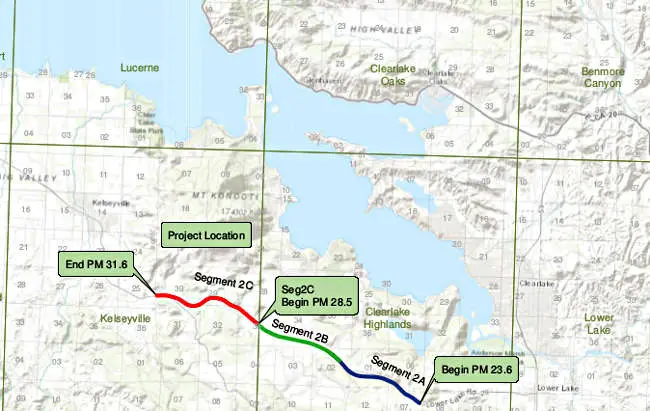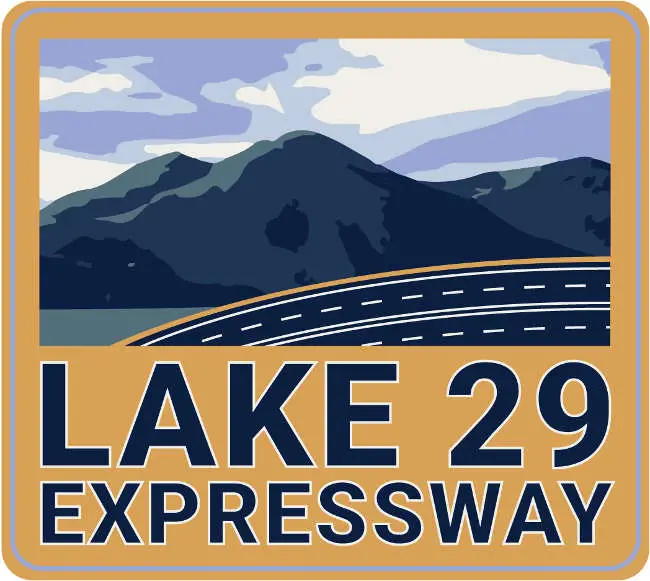LAKE COUNTY, Calif. – Decades in the making, construction is underway on the first segment of the Highway 29 expressway, the largest highway project in the county in 50 years.
Caltrans held a virtual groundbreaking on July 17 for the Lake 29 Expressway, a $59 million project aimed at addressing the area's most significant safety concerns – reducing collision rates for motorists and accommodating truck transportation along the interregional east-west highway.
Due to the restrictions of COVID-19, Caltrans District 1 produced a virtual groundbreaking ceremony video for the Lake 29 Expressway Project.
The video, which can be seen above, explains the project and its objectives and recognizes stakeholders, including the Lake Area Planning Council, the Lake County Board of Supervisors, local tribes, and state and federal agencies.
The funding for the Lake 29 Expressway, a vital east-west corridor between Interstate 5 and U.S. Highway 101, is funded by federal, state and local financing.
This newly launched project, located between Kelseyville and Lower Lake, is the first funded segment of a three-part series.
It will include safety improvements and safe mobility for multiple modes; improve large commercial truck transportation, goods movement and services; reduce traffic on Highway 20 and promote opportunities for complete streets and traffic calming on the Northshore; improve wildfire access and emergency response access; and provide a capacity area for population growth.
"Caltrans' No. 1 priority is safety, and the Lake 29 Expressway Project will enhance safety for motorists and pedestrians throughout Lake County,” said Caltrans Director Toks Omishakin. “This project is designed to reduce collisions on State Route 29, while also providing increased wildfire and emergency response access for the community."
Omishakin explained, “It’s important to note that this project is pivotal in the movement of goods and services for people throughout Northern California.”
He said the project also will have an impact on Lake County’s Northshore, where Caltrans plans further enhancements on Highway 20, which serves as the main street for several small communities. Those projects would make conditions safer for bikes and pedestrians and foster a sense of community, he said.
"I'd like to thank Caltrans for their constant vision to make our roads in Lake County safer," said Lake County District 5 Supervisor Rob Brown. "The realignment will allow truck traffic to divert from Highway 20 to Highway 29, to make things safer for the north end of our lake. It's fun to see it from the beginning of its inception and watch it get to here."
"Since 1988, there has been a dedicated team of experts working together on the Lake 29 Project, providing a safer and more efficient expressway to the traveling public," said Lisa Davey-Bates, executive director of the Lake Area Planning Council.
Like Omishakin, Davey-Bates pointed to countywide benefits. She said encouraging regional and interregional traffic along the south county Highway 29 will also benefit the communities on Highway 20’s Northshore, where traffic calming and pedestrian improvements will continue to be a priority.
"We are here to celebrate what this project means to all of Lake County, which is part of a collective long-term vision, and we wouldn't be here without the partnership of the county of Lake and partnership with the State of California," said State Senator Mike McGuire, whose Second Senate District includes Lake County.
Caltrans said site work in the area – including removing of trees and vegetation, and moving of utilities – began this spring.
Construction, managed by O.C. Jones, is anticipated to be completed in the winter of 2022, said Caltrans spokeswoman Bonnie Kuhn.

Project aims to increase safety
Last fall, the firm O.C. Jones – which has worked on other major highway projects around Lake County – won the expressway project with the low bid of $53.3 million, Caltrans Resident Engineer Kassaye Seyoum told Lake County News.
Caltrans Project Manager Jaime Matteoli said the bid came in lower than the total funding amount available for the project. Seyoum said the bid was 17.4 percent, or about $10.2 million, under the engineer’s estimate.
On the drawing board since the late 1980s, Caltrans staff said the overall Lake 29 Expressway project covers about 8 miles.
This first segment, called “2C,” is about 3 miles long. It will extend from Diener Drive near Lower Lake to just north of Highway 175/Cobb, about half a mile west of Red Hills Road near Kelseyville.
The other two portions, segment “2A” and “2B,” each less than 3 miles long, are to the east of 2C and are now being designed. Caltrans staff said there isn’t yet funding for those future project sections, although they’ve cleared the environmental requirements and have the funds for design work.
The 2C stretch of the project was determined to be a priority as it will meet the traffic flow needs in the areas of the county that are growing the fastest, Caltrans staff said.
That area also has been identified as having a high number of fatal collisions, which Caltrans said justified such a large project.
One of the project benefits will be greater sight distance, said Seyoum.
Other benefits, Matteoli said, will include bigger highway shoulders, two lanes in each direction with plenty of width for passing, curves that are up to current highway standards, three or four acceleration and deceleration lanes, a smoother and easier drive and a full-width median. It also will create opportunities for vehicles to more safely pass.
As such, Matteoli said collisions – particularly head-ons – should be reduced.
During construction, Seyoum said one of the more challenging aspects will be excavation.
There will be sandblasting and removal of a large amount of rock. About 800,000 cubic yards of material will be excavated with about 350,000 cubic yards of material – not all of it rock – to be removed as part of the work, Seyoum said.
One of the project’s main proponents for 30 years was Phil Dow of the Lake Area Planning Council, who retired in 2018.
“We wouldn’t be where we are today without Phil’s help,” said Matteoli.
Matteoli added that the project also likely wouldn’t have been possible without the help of the Lake Area Planning Council, which has been very engaged, persistent and patient through the years.
A lengthy project history
In a 2017 interview about the Lake 29 Expressway project, Dow – a longtime traffic planner and engineer – told Lake County News, “I was there in 1989 when the Area Planning Council made it a priority.”
He said of the lengthy time frame, “This is the way that large transportation projects go,” noting that sometimes it takes 10 years to do a very small one.
In the years since, the Lake Area Planning Council dedicated millions of dollars – the bulk of its regional share of State Transportation Improvement Program funding – to working with Caltrans on specific project components – environmental studies, design, right-of-way and construction, Dow said.
When the Lake Area Planning Council Board made this particular project a priority for state highway projects in Lake County, the No. 1 reason was safety, with Dow pointing to a high number of traffic fatalities.
Another reason for the project was the future capacity for the highway system, with Dow noting that stretch of highway’s heavy use by commuters between Clearlake and Lakeport, as well as recreational traffic and some trucks.
Officials also have wanted to reroute more traffic from Highway 20 to Highway 29, including trucks, because of constraints to Highway 20’s traffic flow. “It wasn’t feasible to widen Highway 20 to accommodate the future highway growth,” he said.
That made Highway 29 the important alternative, even though it creates a further travel distance, as that highway can be widened and offer more passing opportunities with four lanes. Dow said, ultimately, the larger expressway project will feed into the existing 7.5 miles of freeway near Lakeport.
Dow said that once the first segment is under construction, it should make it easier to get the funding for the rest of the work.
He also noted that there have been times over the last several years when there wasn’t any funding available for such projects, and that changing that was a political effort that involved the Legislature, regional agencies, cities and counties.

Long-term vision yields project
Davey-Bates said the Lake 29 Expressway is Lake County’s largest highway project in the last 50 years.
While Caltrans is the lead agency on the expressway, Davey-Bates explained that the Lake Area Planning Council is the regional transportation planning agency in Lake County that administers funding from the state and federal government for these types of projects.
“It’s been quite the uphill battle,” Davey-Bates of getting the expressway project to this point.
However, once the final dollars were in place and environmental and design work were underway, the challenges started to wind down. Then, she said, there was a waiting period.
“We’re so excited that we’re finally to that point because it has been such a long time coming,” she said. Referring to the decades since the project was first initiated, she said, “That’s why they call us long term planners.”
Highway 29 is a principal arterial corridor, and the project will improve both the safety and the highway’s operations by encouraging traffic, especially truck traffic, to go around Highway 53 and down around south of the lake, where more growth is expected, she said.
Davey-Bates said that eventually, as part of the overall planning, there are plans for more traffic calming measures on the Northshore to make it more pedestrian and bike-friendly and to encourage safety.
Earlier this year, a Highway 20 corridor planning study was completed, with the Area Planning Council approving it at its May meeting. Davey-Bates said the planning document looks at improvements to the corridor for bike and pedestrian transit improvements.
She said the two projects – the expressway and improvements on Highway 20 – will work in tandem to improve the flow of traffic through the Southshore and improve the Northshore.
The Area Planning Council has, to date, contributed $15,441,000 of its State Transportation Improvement Program funding to the expressway project, she said. Millions more have come from other sources, like the State Highway Operation and Protection Program, or SHOPP.
Davey-Bates said a lot of safety money has gone into the project because it has had such a high rate of injury and fatality crashes. “That’s not a normal situation.”
Caltrans has not historically allocated SHOPP funding on capacity-increasing projects, but this time they stepped up to the plate, Davey-Bates said.
While Lake County is small it has a lot of miles of roads, and Davey-Bates said Caltrans has worked hard to keep the state highways that pass through the county in good condition.
On this project, Davey-Bates said Caltrans will do its best to minimize the delays for motorists.
She said she hopes people will be patient and realize that, “in the end, we’ll be saving lives and improving the facility and it will be worth the wait.”
Davey-Bates said the goal now is to get funding for the last two sections of the project through grants and a federal bill.
They’re through the design process and just need construction funding, Davey-Bates added.
“We’re so close,” she said.
Email Elizabeth Larson at This email address is being protected from spambots. You need JavaScript enabled to view it. . Follow her on Twitter, @ERLarson, or Lake County News, @LakeCoNews.

 How to resolve AdBlock issue?
How to resolve AdBlock issue? 





